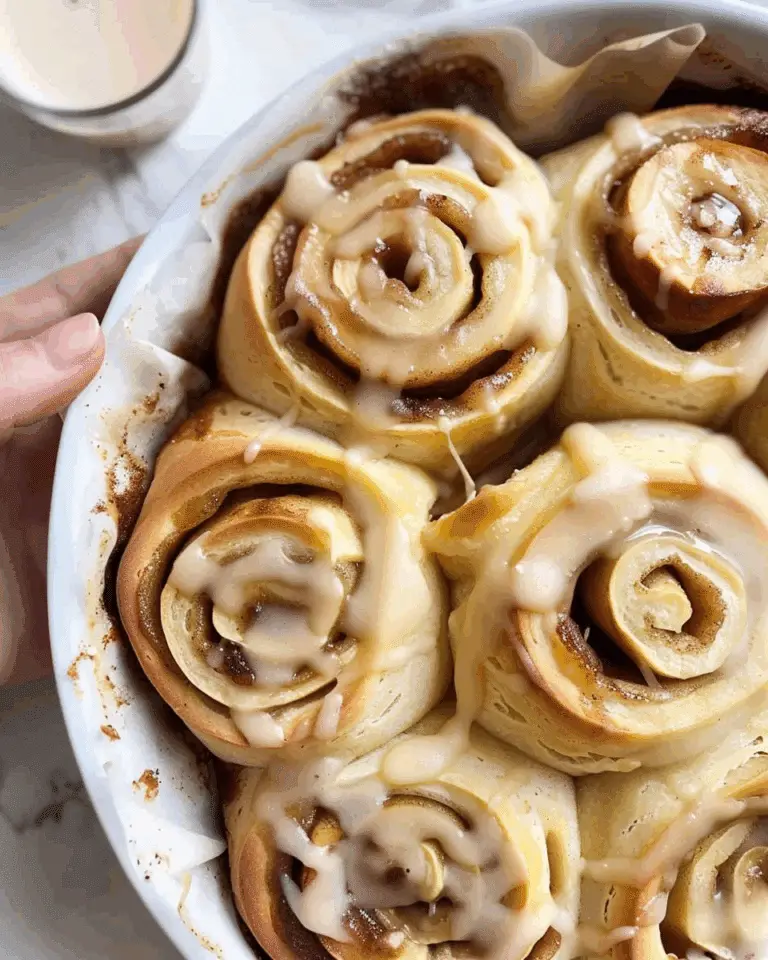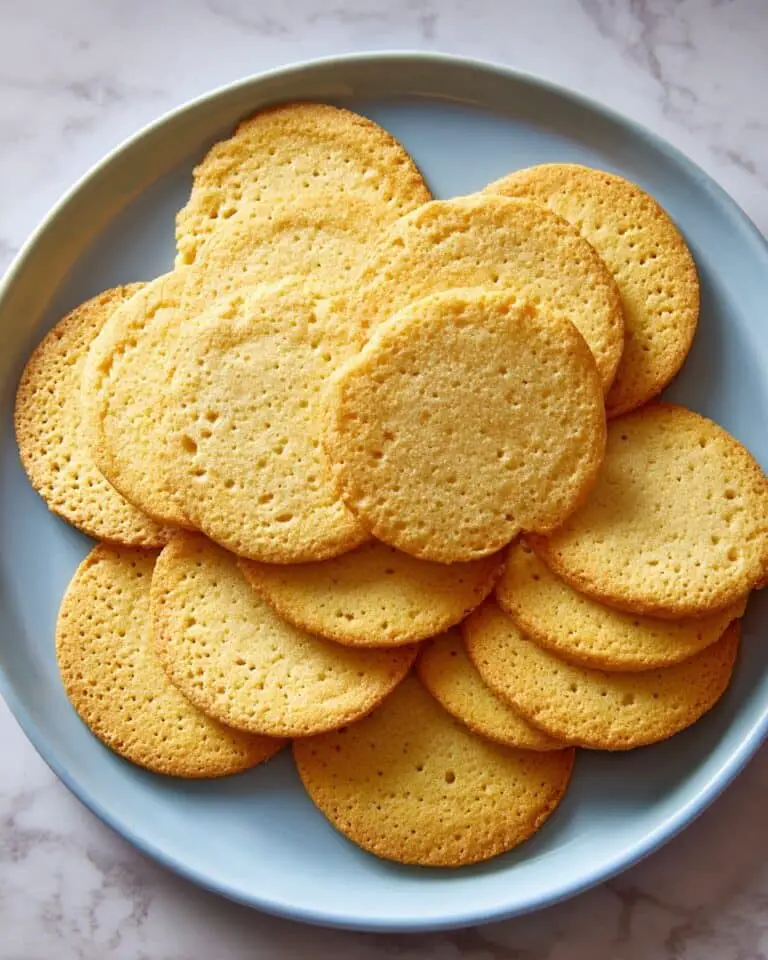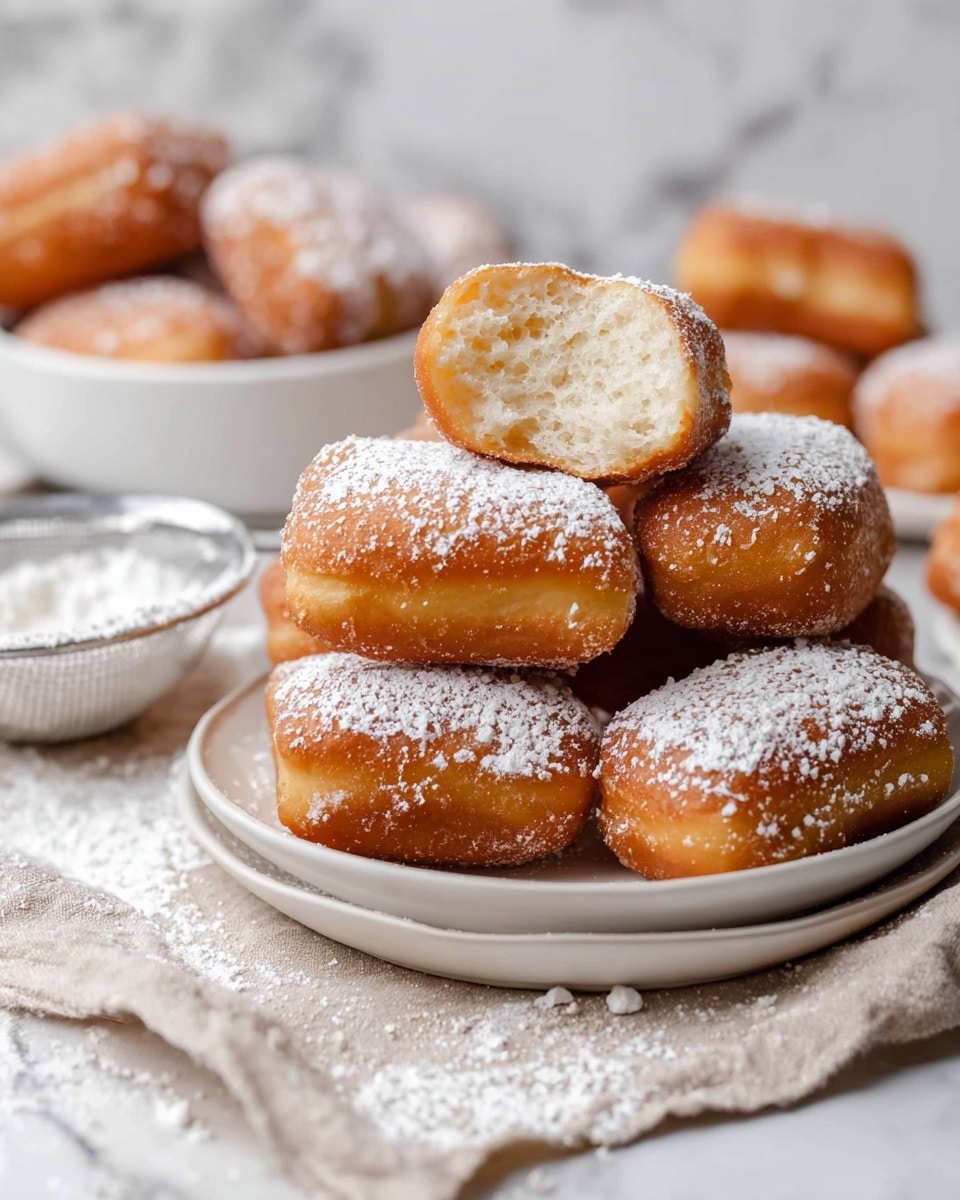
If you have a soft spot for treats that bring a bit of a Parisian cafe vibe into your kitchen, this Homemade Beignets with Powdered Sugar Recipe is an absolute must-try. Imagine pillowy, golden puffs with a delicate crunch, dusted generously with sweet powdered sugar that melts just a bit on top. These beignets are not only addictive but also surprisingly approachable, letting you savor the joy of frying up fresh pastries anytime you crave a tender, sugary bite. Whether for breakfast, dessert, or a delightful snack, these beignets will quickly become a treasured recipe in your collection.
Ingredients You’ll Need
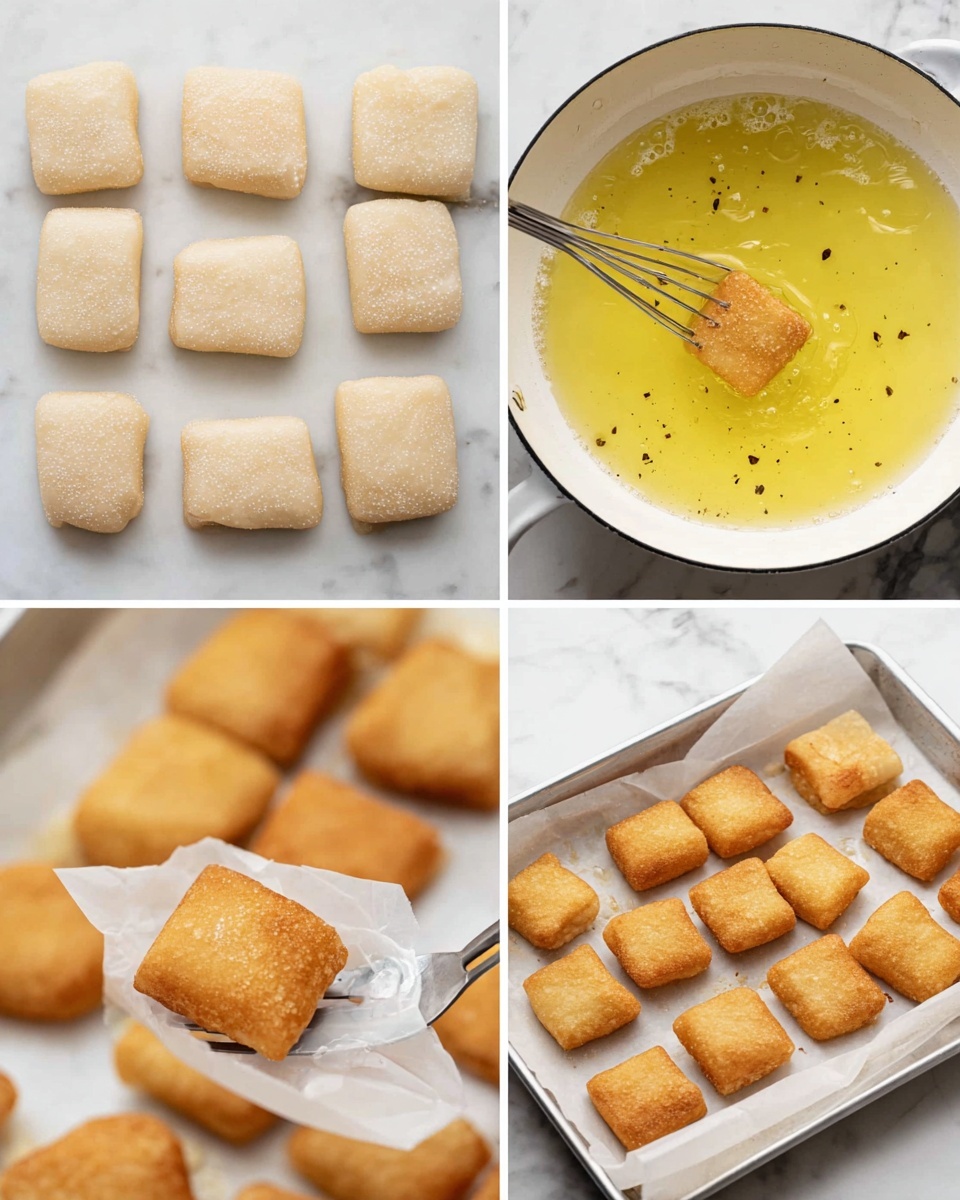
What makes this recipe shine are its simple, everyday ingredients, each playing a crucial role in crafting the perfect texture and flavor. From the milk that creates moisture for the dough to the butter that enriches its softness, every component is essential to achieving that iconic beignet crunch and melt-in-your-mouth softness.
- Whole milk (lukewarm): Helps activate the yeast and provides the dough with tender moisture.
- Granulated sugar: Adds subtle sweetness that balances the fried dough’s richness.
- Fresh yeast: Essential for a light, fluffy rise, but instant yeast works well too.
- Egg yolk and egg (room temperature): They bind the dough and enrich its texture and color.
- Bread flour: Offers high protein to develop the dough’s structure; all-purpose flour is a fine alternative.
- Salt: Enhances all the flavors and balances the sweetness.
- Unsalted butter: Adds richness and tenderness to the dough.
- Vegetable or canola oil (for frying): Provides a neutral frying medium that crisps the beignets beautifully.
- Powdered sugar: The classic finishing touch that adds sweetness and charm.
How to Make Homemade Beignets with Powdered Sugar Recipe
Step 1: Activate the yeast
Start by mixing granulated sugar into lukewarm milk, then sprinkle fresh yeast on top. Place this mixture in a warm spot and let it foam for about 10 minutes. This foaming confirms your yeast is alive and ready to make your dough rise fluffy and light.
Step 2: Combine wet ingredients
Transfer the foamy yeast mixture into your stand mixer bowl fitted with a kneading hook, then add the egg and egg yolk. Mixing these together ensures the dough gains richness and structure right from the start.
Step 3: Add dry ingredients
Now add the flour and salt into the wet mix. Start kneading until the dough just begins to come together. This phase builds the foundation for that perfect chewy yet soft beignet texture.
Step 4: Incorporate the butter
Slowly add softened butter chunks, a few at a time, kneading continuously. Keep at it for about 10 minutes on medium-high speed until the dough shines with elasticity and no longer sticks. This step is key to achieving that melt-in-your-mouth softness.
Step 5: First rise
Place your dough in a bowl, cover it with plastic wrap or a towel, and let it rest. Ideally, keep it in the fridge overnight or at room temperature for 1 to 2 hours until it doubles in size. This slow rise develops flavor and gives your beignets a delightful airy texture.
Step 6: Deflate and knead gently
Once risen, punch down the dough to knock out excess air, then knead it lightly just to smooth it out. This ensures an even crumb and prevents large pockets of air in your beignets.
Step 7: Roll and cut
On a lightly floured surface, roll out the dough to about a quarter inch thick (0.6mm), then use a pizza cutter to slice it into 6 cm squares. Light dusting of flour here keeps the dough from sticking as you shape your adorable treats.
Step 8: Prepare for the second rise
Arrange the squares on baking paper and allow them to proof again at room temperature for 1 to 2 hours, until they puff up nicely. Find a warm but indirect spot to encourage perfect proofing without drying out the dough.
Step 9: Heat the oil
While your beignets proof, heat your vegetable or canola oil to about 180°C (356°F). Using a thermometer is the best way to keep the temperature steady for evenly golden, crispy beignets.
Step 10: Fry to perfection
Carefully place 6 to 8 pieces into the hot oil, leaving space to avoid sticking. Fry each side for about 1.5 minutes until golden brown and puffed. This quick, hot bath seals in the lightness and creates that irresistible crunch.
Step 11: Drain and dust
Remove the beignets with a slotted spoon and place them on a wire rack lined with paper towels to soak up excess oil. While still warm, toss them in powdered sugar to coat generously. This final touch is classic and absolutely heavenly.
Step 12: Serve immediately
Beignets are best enjoyed fresh, warm and sugary. Their crisp exteriors give way to cloud-like interiors that make every bite unforgettable.
How to Serve Homemade Beignets with Powdered Sugar Recipe
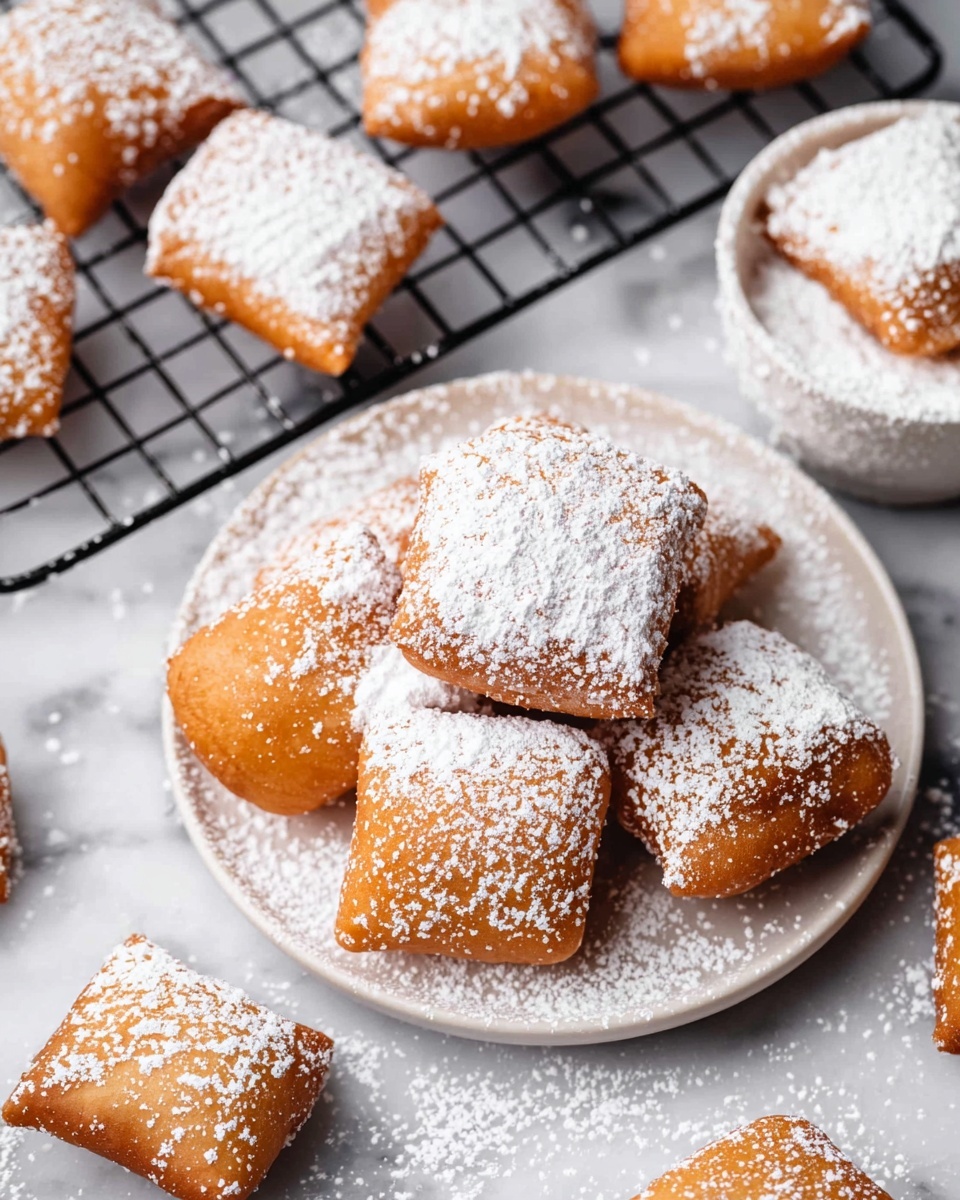
Garnishes
While the traditional powdered sugar topping is iconic, you can sprinkle your beignets with cinnamon sugar for a spicy twist or drizzle with a bit of melted chocolate or caramel for extra indulgence. Fresh berries on the side brighten up the plate and add fresh notes.
Side Dishes
Pair these beignets with a rich café au lait or a steaming cup of hot chocolate to complete your cozy café-inspired experience. For a brunch vibe, fresh fruit salad or a dollop of whipped cream can elevate the meal further.
Creative Ways to Present
For an eye-catching presentation, serve beignets stacked in a pyramid dusted heavily with powdered sugar on a rustic wooden board or place each puff in a mini cupcake liner to keep them neat and easy to handle. A small dipping bowl of crème anglaise or berry coulis next to each plate adds a splash of color and flavor.
Make Ahead and Storage
Storing Leftovers
If you have any leftovers, store them at room temperature in an airtight container for up to two days. While they lose a bit of crispness over time, the flavor remains delightful, and a gentle reheat helps revive their freshness.
Freezing
You can freeze unfried, shaped dough pieces before the second rise by placing them on a baking sheet until firm, then transferring to a freezer bag. When ready, thaw and proof fully before frying. This little prep hack means you can enjoy fresh beignets anytime.
Reheating
To bring back the fresh-fried glory, reheat leftovers in a low oven (around 170°C/340°F) for 5 to 7 minutes or pop them briefly in a toaster oven. Avoid microwaving as it softens the crunch you love.
FAQs
Can I use instant yeast instead of fresh yeast?
Absolutely! Substitute 1.5 teaspoons (5g) of instant yeast for fresh yeast. Just mix it right in with the dry ingredients and skip the activating step.
What oil is best for frying beignets?
Neutral oils with high smoke points like vegetable or canola oil work best. They fry evenly without imparting unwanted flavors and help achieve that perfect golden crust.
How thin should I roll the dough?
About a quarter inch thick (0.6 mm) is ideal. Too thin and the beignets might be too crispy and fragile; too thick and they may be doughy inside.
Can I make these beignets gluten-free?
Traditional beignets rely on gluten for structure, so substituting flour is tricky. However, experimenting with gluten-free blends that include xanthan gum might work, though texture may vary.
How do I know when the oil is at the right temperature?
A thermometer is your best friend here, aiming for around 180°C (356°F). If you don’t have one, test by dropping a small piece of dough into the oil — it should sizzle and rise immediately but not burn.
Final Thoughts
There is something truly magical about making Homemade Beignets with Powdered Sugar Recipe right in your own kitchen. From the simple joy of watching your dough rise to the warm, sugary bites fresh from the hot oil, this recipe invites you to share a special moment with friends or family. Don’t hesitate to dive in – beignets are as fun to make as they are delicious to eat, and every step brings you closer to a little taste of happiness.
Print
Homemade Beignets with Powdered Sugar Recipe
- Total Time: 9 hours 45 minutes (including overnight rise and proofing times)
- Yield: 24 servings
Description
Classic French beignets featuring a soft and airy dough made with fresh yeast, milk, butter, and eggs, fried to golden perfection and dusted with powdered sugar. Ideal as a sweet treat or breakfast delight, these beignets are crispy on the outside and tender inside.
Ingredients
Dough Ingredients
- 110 g Whole milk (lukewarm)
- 50 g Granulated sugar
- 12.5 g Fresh yeast (or 1.5 teaspoons / 5g instant yeast)
- 1 Egg yolk (room temperature)
- 1 Egg (room temperature)
- 250 g Bread flour (or all-purpose flour)
- ¼ teaspoon Salt
- 60 g Unsalted butter (room temperature, soft)
For Frying
- 1.5 liters Vegetable or Canola oil
For Serving
- 60 g Powdered sugar
Instructions
- Activate the yeast: Mix the sugar with lukewarm milk and sprinkle the fresh yeast on top. Keep the mixture in a warm environment until the yeast foams, about 10 minutes.
- Combine wet ingredients: Place the yeast mixture in a stand mixer with a dough hook, then add the egg and egg yolk and mix well.
- Add dry ingredients: Incorporate the bread flour and salt into the wet ingredients and start kneading until the dough begins to come together.
- Incorporate butter: Gradually add softened butter in small chunks while kneading on medium-high speed for about 10 minutes until the dough is elastic, shiny, and no longer sticky.
- First rise: Transfer the dough to a bowl, cover with plastic wrap or a towel, and allow it to rise ideally overnight in the fridge or at room temperature for 1-2 hours until doubled in size.
- Deflate and knead: Punch down the dough to release air and gently knead for a few seconds.
- Shape the dough: Roll the dough on a lightly floured surface to about 1/4 inch (0.6 cm) thickness. Cut into 6 cm (2.5 inch) squares using a pizza wheel or knife, using flour as needed to prevent sticking.
- Prepare for second proofing: Place the cut dough squares on sheets of baking paper and allow them to proof at room temperature in a warm spot, avoiding direct sunlight, for 1-2 hours until puffed up.
- Heat oil: Heat vegetable oil in a heavy-bottomed pan to 180°C (356°F), maintaining between 175-185°C (347-365°F) with a thermometer for optimal frying.
- Fry beignets: Fry 6-8 pieces at a time, giving them room to float freely. Cook each side for about 1.5 minutes until golden brown and crisp.
- Drain and dust: Place fried beignets on a wire rack lined with paper towels to remove excess oil. While still hot, dust generously with powdered sugar.
- Serve and store: Enjoy beignets fresh. Store leftovers in an airtight container at room temperature for 1-2 days.
Notes
- Use fresh yeast for authentic flavor, but instant yeast is a convenient substitute.
- Ensure the dough is not sticky before first proofing—add flour sparingly if needed during kneading.
- Maintaining correct oil temperature is crucial for perfectly fried beignets; too hot oil burns them, too cool makes them greasy.
- Be gentle when handling risen dough to preserve airiness.
- Serve beignets immediately for best texture and taste.
- Prep Time: 30 minutes
- Cook Time: 15 minutes
- Category: Dessert
- Method: Frying
- Cuisine: French


